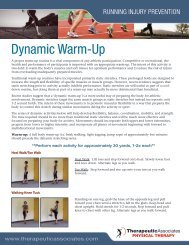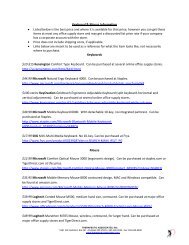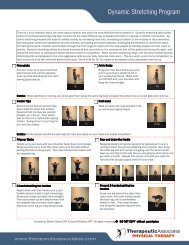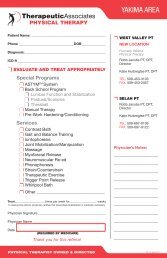Dynamic Warm Up and Cool Down - Therapeutic Associates
Dynamic Warm Up and Cool Down - Therapeutic Associates
Dynamic Warm Up and Cool Down - Therapeutic Associates
Create successful ePaper yourself
Turn your PDF publications into a flip-book with our unique Google optimized e-Paper software.
EVERY DAY FITNESS<br />
PERFORMANCE RUNNING<br />
<strong>Dynamic</strong> <strong>Warm</strong> <strong>Up</strong> <strong>and</strong> <strong>Cool</strong> <strong>Down</strong><br />
A dynamic warm-up should be performed prior to activity to prepare the body for the dem<strong>and</strong>s<br />
of a workout. <strong>Dynamic</strong> movements are the best way to prepare your body for dynamic<br />
workouts. Contrary to old beliefs, the best time to work on static flexibility is at the end of your<br />
workout, <strong>and</strong> not in the beginning. After every workout you should follow a total body static<br />
stretching series.<br />
The great thing about a comprehensive dynamic warm-up is that it does not take any more<br />
time than the more traditional stretching method, but is much more focused, effective, <strong>and</strong><br />
productive. Since your warm-up sets the tone for the entire workout, these are just the qualities<br />
you should be looking for.<br />
The specific advantages of a dynamic warm-up, by comparison with the more traditional “sit<br />
<strong>and</strong> stretch” routine, are as follows:<br />
• Increases core body temperature <strong>and</strong> blood flow to muscles.<br />
• Enhances muscle elasticity <strong>and</strong> lubricates joints.<br />
• Increases heart rate <strong>and</strong> respiratory rate which is the body’s preparation for the dem<strong>and</strong>s of a<br />
workout.<br />
• It prepares the muscles <strong>and</strong> joints in a more sport specific manner than static stretching.<br />
• It enhances coordination <strong>and</strong> motor ability as well as revving up the nervous system.<br />
A series of dynamic movements will develop flexibility, balance, coordination, mobility, <strong>and</strong><br />
strength.<br />
<strong>Dynamic</strong> <strong>Warm</strong>-<strong>Up</strong><br />
The idea of the dynamic warm-up routine is to do some basic leg stretches while moving/<br />
walking. Remember to keep good posture <strong>and</strong> think about the motions <strong>and</strong> technique of<br />
each movement. <strong>Warm</strong>- up with exercises for both the upper <strong>and</strong> lower extremities; progress<br />
from low to a higher intensity; including all planes of motion, start forward <strong>and</strong> progress to<br />
multidirectional movements.<br />
A full body warm-up (i.e. walking, light jogging, jump rope) of approximately 5 minutes should<br />
precede the dynamic series. Always remember warm-up to stretch, do not stretch to warm-up.<br />
www.therapeuticassociates.com/PerformanceRunning
EVERY DAY FITNESS<br />
PERFORMANCE RUNNING<br />
<strong>Dynamic</strong> <strong>Warm</strong> <strong>Up</strong> <strong>and</strong> <strong>Cool</strong> <strong>Down</strong>: Continued<br />
Perform each activity for approximately 30 yards, 2x each<br />
High Knee Explosion Skips<br />
Step forward on right foot then drive left<br />
leg up <strong>and</strong> forward while hopping on right,<br />
l<strong>and</strong> on left foot. Continue by hopping on<br />
left foot while driving right leg up <strong>and</strong><br />
forward. Go for height <strong>and</strong> explosion.<br />
Pattern: Step right, Hop right, L<strong>and</strong> left,<br />
Hop left.<br />
Straight Leg Kick Skips<br />
Keeping legs <strong>and</strong> back straight kick<br />
one leg up to opposite h<strong>and</strong>. Keep arm<br />
shoulder level parallel to floor with head<br />
<strong>and</strong> chest up. Step forward with raised<br />
leg <strong>and</strong> repeat exercise with other leg.<br />
Continue in same direction; left then right<br />
is one rep.<br />
Grapevine/Karioka<br />
Run sideways, cross one leg in front of the<br />
other, bring other leg out to side, then bring<br />
first leg behind the other <strong>and</strong> front leg out<br />
to the side…<strong>and</strong> so on. Keep toes forward<br />
<strong>and</strong> bend knee into squat as tolerated.<br />
Keep head <strong>and</strong> chest up with lower squats.<br />
High Knee Skips<br />
Running, raise knees high up towards<br />
chest.<br />
Progressive Lungs<br />
Push off with one foot <strong>and</strong> lunge forward<br />
onto the other, keeping front shin vertical.<br />
Push up from front foot <strong>and</strong> advance self<br />
forward. Keep head <strong>and</strong> chest up.<br />
Lateral Shuffles<br />
Run sideways with one foot stepping to<br />
the other foot <strong>and</strong> then away. Keep toes<br />
forward <strong>and</strong> bend knee into squat as<br />
tolerated. Keep head <strong>and</strong> chest up with<br />
lower squats.<br />
Butt Kick Skips<br />
Running, raise heels towards buttocks.<br />
Drawing images used with permission by VHI<br />
www.therapeuticassociates.com/PerformanceRunning
EVERY DAY FITNESS<br />
PERFORMANCE RUNNING<br />
<strong>Dynamic</strong> <strong>Warm</strong> <strong>Up</strong> <strong>and</strong> <strong>Cool</strong> <strong>Down</strong>: Continued<br />
<strong>Cool</strong> <strong>Down</strong><br />
It is optimal to end your work out with a cool down series. This does not have to be long,<br />
but rather is a transition period to prepare your body for static stretching.<br />
The advantages of a cool down are as follows:<br />
• Allows your heart rate <strong>and</strong> blood pressure to slow gradually.<br />
• Helps to avoid dizziness or fainting that can sometimes occur with suddenly stopping<br />
an active work out.<br />
• It allows your body time to reset <strong>and</strong> relax prior to stretching.<br />
• Helps to flush waste products.<br />
• Decreases post work out soreness <strong>and</strong> enhances recovery time.<br />
• The transition feels really good.<br />
<strong>Cool</strong> <strong>Down</strong> Ideas<br />
• Decrease your pace, moving to a slow jog or walk for 5-10 minutes.<br />
• Progress from a walk , to long slow strides.<br />
• Walk backwards with emphasis on allowing your heel to come fully to the ground.<br />
• Hydrate.<br />
• Breathe.<br />
Now head to your static stretching routine.<br />
www.therapeuticassociates.com/PerformanceRunning


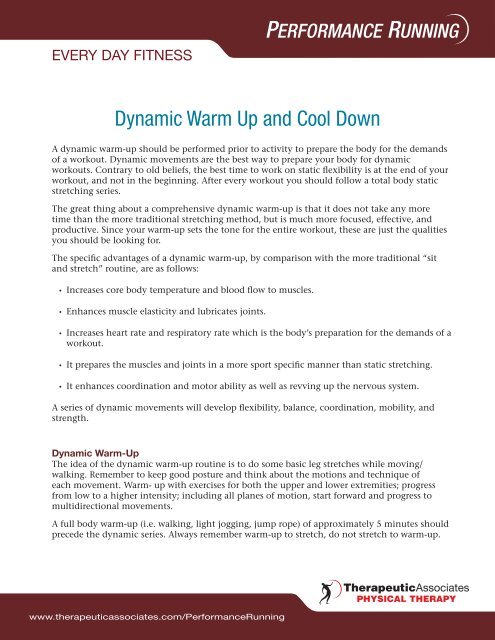

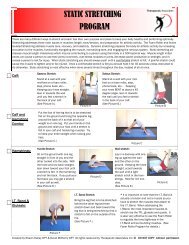
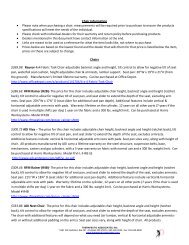

![[02] NAIOMT C-516 Cervical Spine I - Therapeutic Associates](https://img.yumpu.com/43449457/1/190x245/02-naiomt-c-516-cervical-spine-i-therapeutic-associates.jpg?quality=85)
